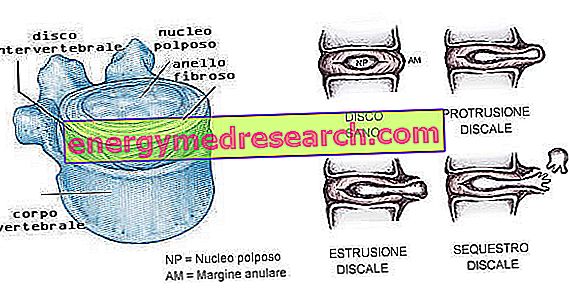Key points
The cervical hernia consists of the escape of gelatinous material from the pulpy nucleus of an intervertebral disc located in the cervical tract. Following the herniation, a sort of protuberance of the intervertebral disk is formed which compresses the nerve roots directed to an arm and / or spinal cord.
Causes
Cervical trauma is the main cause of cervical hernia; among these we mention: increased loads on the spine, whiplash, inclination of the vertebrae, weakening of the disc caused by aging, cervical spondylosis.
Symptoms
The main symptom of cervical hernia is neck pain (cervicalgia) which tends to radiate along the arm (brachialgia). The pain can be accompanied by secondary symptoms: weakness of the upper limbs, tingling in the arms, headache and spinal cord compromise (myelopathy).
Diagnosis
A cervical hernia is confirmed by multiple diagnostic tests: CT, MRI, neck radiography, myelography, discography, electromyography.
Treatment and therapy
- Conservative therapy (indicated for mild hernias) → intake of NSAIDs, corticosteroids, muscle relaxants, use of the cervical collar, physiotherapy
- Surgical therapy (for severe forms of cervical hernia) → anterior and posterior discectomy
Definition of cervical hernia
The cervical hernia (or cervical disc hernia ) can be defined as a protrusion of an intervertebral disc of the cervical tract, which compresses the nerve roots directed to an upper limb and, sometimes, also the spinal cord. Although it is a benign disease, the cervical hernia is perceived as a highly debilitating discomfort, since it begins with intense, penetrating and persistent pain. The patient suffering from cervical hernia therefore needs rest, the only possible solution to calm the pain.
A little anatomy to understand ...
The cervical spine consists of 7 vertebrae articulated in different ways; these vertebrae are identified with the letter C, and progressively numbered from C1 to C7.
The first and second cervical vertebra - called the atlas and the axis respectively - make up the upper cervical spine: there is no intervertebral disc here, so it is not possible to create a herniation.
Cervical hernias can instead be established in the lower cervical spine, consisting of the remaining 5 vertebrae (C3-C7).
Each disk consists of:
- Pulpy core, consisting of a gelatinous substance composed of 88% water
- Concentric fibrous rings ( anulus fibrosus): they contain the nucleus and protect it from sudden movements and heavy loads, preventing the escape of the gelatinous substance from the disc
- Anterior and posterior longitudinal ligaments, whose function is to strengthen the annulus. At the cervical level, the posterior ligament must fulfill a very important function, namely to protect the spinal cord. For this purpose, this ligament is powerful and broad.
- The rupture of the fibrous ring causes the pulpy nucleus to escape from its seat (cervical hernia).

Cervical hernia occurs most frequently at the level of C4-C5, C5-C6 and C6-C7.

Causes
The cervical hernia is essentially caused by the laceration of the fibers containing the fibrous ring (which constitute the disc wall).
Wear and degeneration of the disc, together with cervical trauma, are the main causes of cervical hernia. More precisely, the patient can contract a cervical hernia in the following situations:
- Wrong attitude and body posture
- Increased loads on the spine
- Flick
- Muscle deficiency and weakness of ligamentous tissues
- Inclination of the vertebrae: the modification of the normal structure of the vertebrae increases the risk of cervical disc herniation
- Physiological weakening of the disc (caused by aging)
- Stresses repeated over time
- Cervical spondylosis (degenerative disease of a cervical disc)
- Vibrations on the spine
Symptoms
The main symptom of cervical hernia is neck pain (cervicalgia), which tends to radiate along the arm (brachialgia).

Pain can be associated with possible compression disorders of the attached nervous structures, located in the vertebral canal (nerve roots and spinal cord). The pressure exerted on the nerve root is called cervical radiculopathy .
Cervical pain is also accompanied by a series of secondary symptoms, such as:
- Sharpening of the pain by rolling the head and stretching the neck
- Spinal cord impairment (cervical myelopathy)
- Arm muscle weakness + persistent cervical pain ( cervicobrachialgia )
- More or less severe motor deficits (eg paresis)
- Difficulty moving the arm
- Tingling in the arms and feeling of electric shock
- Hypomobility of the upper limb
- Headache
- Sensation of pin punctures at the cervical level
In the most serious cases, the disc hernia invades the cervical canal, thus compressing the bone marrow: in similar situations, the symptoms of herniation also have repercussions at the level of the leg (myeloradiculopathy).

In details...
Hard and soft cervical hernia
SOFT CERVICAL HERNIA
These are exclusive herniations of the nucleus pulp which are characterized by an extrusion of the cervical disc into the neural canal. Soft cervical hernia is caused by wear and degeneration of the disc, often as a result of traumatic events or whiplashes.
The soft variant of cervical hernia is found mainly at the level of the C6 and C7 vertebrae (70-80% of the diagnosed cases of soft cervical hernia) and between C5 and C6 (20-30%). The soft cervical hernia particularly affects subjects under the age of 50.
The most common symptoms are:
- Neck pain that radiates along the arm
- More intense and penetrating pain on awakening
- Stiff neck
- Sensation of constant rigidity at the cervical level
Many patients compare the pain derived from a hernia at C5-C6 level to that triggered by a myocardial infarction.
HARD CERVICAL HERNIA
The herniation is characterized by a degeneration of the nucleus pulposus associated with a margino-somatic osteophytosis:

Symptoms tend to begin gradually: patients suffering from the hard variant of cervical hernia report a radicular pain which is often associated with alterations of osteo-tendon reflexes and muscular deficits.



